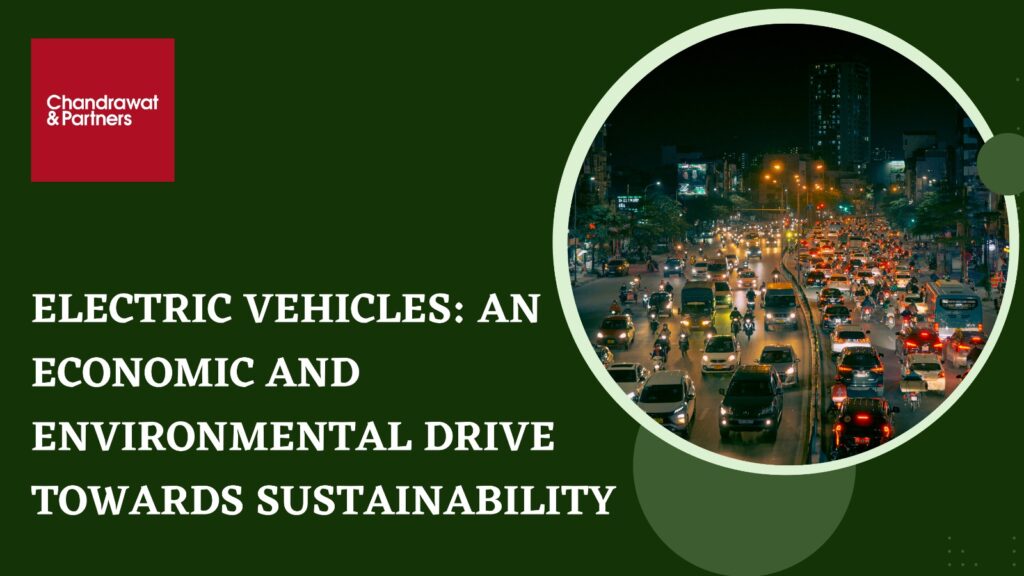Electric vehicles: An economic and environmental drive towards sustainability
Electric passenger vehicles, launched more than a century ago, are now recognised in key markets such as China, the United States, and Europe as part of the solution to rising global pollution. The term electric vehicle refers to vehicles deploying electric motors for propulsion. However, the shift to e-mobility has been delayed in low- and middle-income nations, owing in large part to concerns over high upfront costs. India is a country that extensively relies on polluting hydrocarbons to power its industry, power plants, and vehicles.
With rising industrialization and population, it is difficult to imagine the repercussions of depletion of non-renewable energy sources. However, in view of the growing worry about climate change, India is on a path to assure the adoption of various eco-friendly energy sources. In this regard, electronic vehicles (“EVs”) are currently viewed as a profitable alternative to traditional gasoline/diesel automobiles. Emerging economies like India can offer a sustainable platform for EVs. While there are challenges to overcome, there are also several opportunities for EV adoption in these economies.
Necessity and affordability of EVs in emerging economy
Many emerging economies face significant challenges related to air pollution and greenhouse gas emissions. EVs offer a cleaner alternative to traditional internal combustion engine vehicles, reducing emissions and improving air quality. The necessity to address these environmental concerns provides a strong impetus for the adoption of EVs.
Governments in emerging economies can play a crucial role in promoting EV adoption. They can implement supportive policies such as financial incentives, tax breaks, subsidies, and exemptions from certain fees or taxes. These measures can help bridge the affordability gap, making EVs more accessible and attractive to consumers.
A robust charging infrastructure is essential for the widespread adoption of EVs. Emerging economies have an opportunity to leapfrog traditional infrastructure and invest in scalable and sustainable charging networks. This can be done by deploying a mix of public charging stations, workplace charging facilities, and incentivizing private charging infrastructure development.
Encouraging local manufacturing of EVs and their components can help reduce costs and increase affordability. Emerging economies can leverage their manufacturing capabilities and resources to develop a domestic EV industry. This can create job opportunities, stimulate economic growth, and reduce dependency on imported vehicles, making EVs more affordable in the long run.
Battery technology is a critical component of EVs, and advancements in this area can help reduce costs and improve affordability. Emerging economies can invest in research and development of battery technologies, collaborate with global manufacturers, and establish battery manufacturing facilities to drive down costs and make EVs more affordable.
Government intervention: Support and incentives
The sustainable development framework is the most important model or framework to consider when developing new technology. Such frameworks take into account various aspects of development, such as social, economic, environmental, and technological factors. Furthermore, the development of international standards and codes, universal infrastructures, associated peripherals, and user-friendly software will be critical to the successful growth of EVs over the next decade.
Governments provide incentives to encourage EV adoption, such as subsidies, and infrastructure development. In India, the government actively encourages the adoption of electric vehicles through the faster adoption and manufacturing of hybrid and electric vehicles. Other key interventions by the government to promote EVs include reduction of goods and services tax on EVs from 12% to 5%, deduction of income tax on the interest paid on loans taken to purchase EVs, introducing green license plates for EVs etc.
Policymakers and various automobile players are taking notice of the lack of infrastructure and as a consequence, quite a few developments have been made to the legal and regulatory regime as well. Collaboration between governments, financial institutions, and the private sector can help address the affordability challenge. Innovative financing models, such as low-interest loans, leasing options, and pay-as-you-go schemes, can make EVs more affordable for consumers. Public-private partnerships can also help mobilize investment and resources to support EV adoption.
The future ahead
Emerging economies can develop a sustainable platform for EVs that balances the need for environmental sustainability with affordability by taking these aspects into account and executing relevant solutions. It will need a collaborative effort from governments, corporations, and consumers to overcome roadblocks and encourage the adoption of EVs as a viable and accessible transportation solution. While the governmental authorities are taking steps to resolve the hurdles and promote growth of manufacturing and adoption of EVs, a major contribution has been made on account of the changing consumer behaviour.
With growing e-commerce where home delivery of various goods and services has become the new normal, delivery companies can play a paramount role in controlling the increased carbon footprint. India is still working on developing the legislation and regulations that will govern the operation of EVs. The government’s target of a paradigm shift to EVs by 2030 appears to be a pipe dream unless more initiatives are taken by the government to raise public awareness and formalise the legal regime surrounding EVs to ensure smoother and faster adaptability of EVs amongst consumers.
For more information or queries, please email us at
enquiries@chandrawatpartners.com




